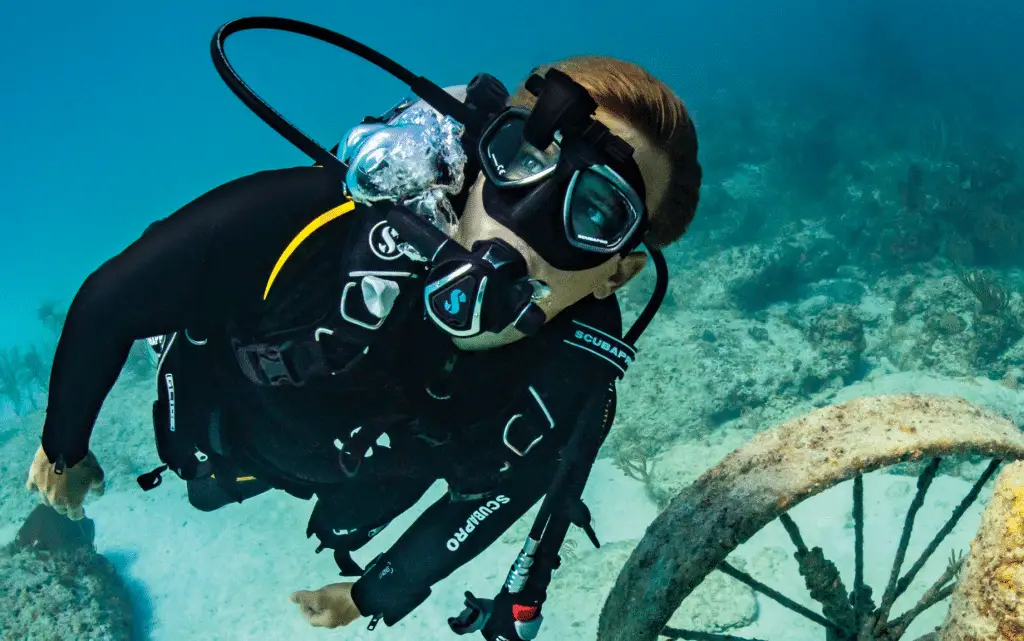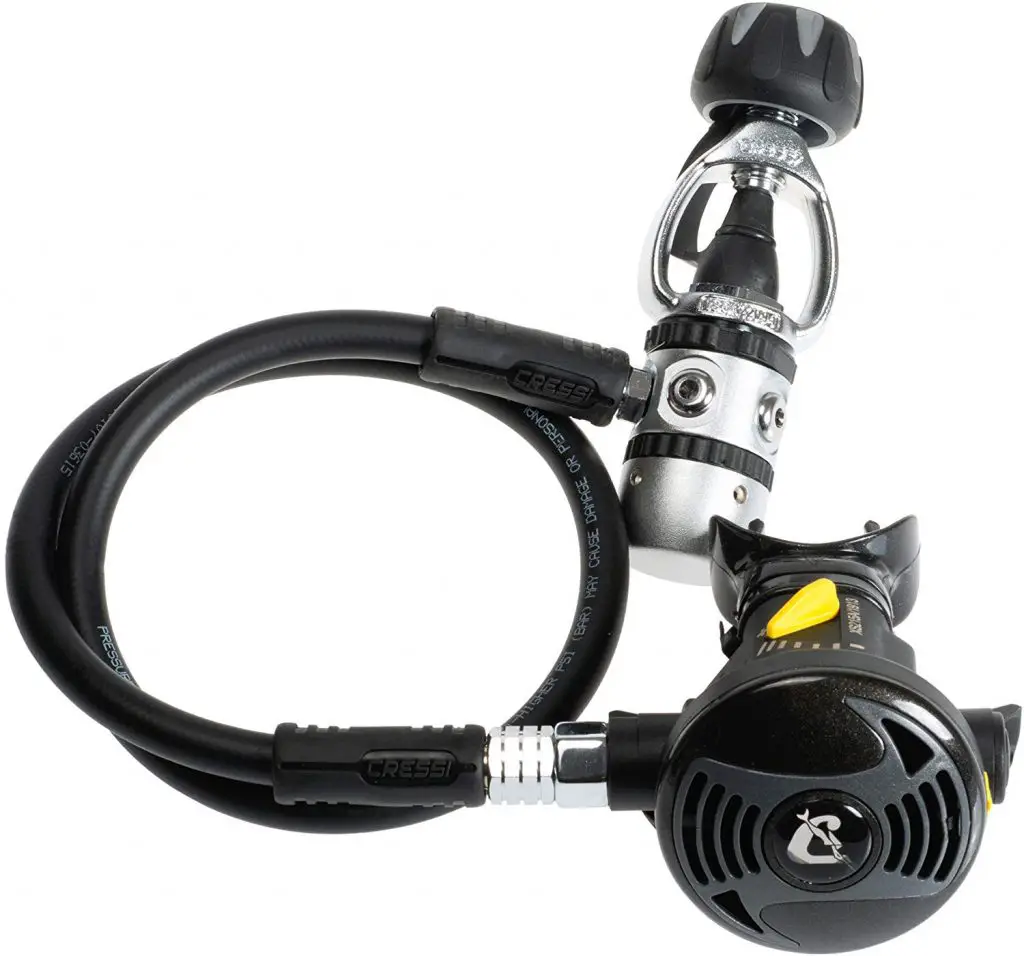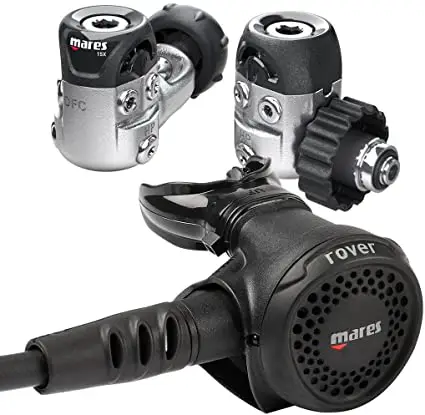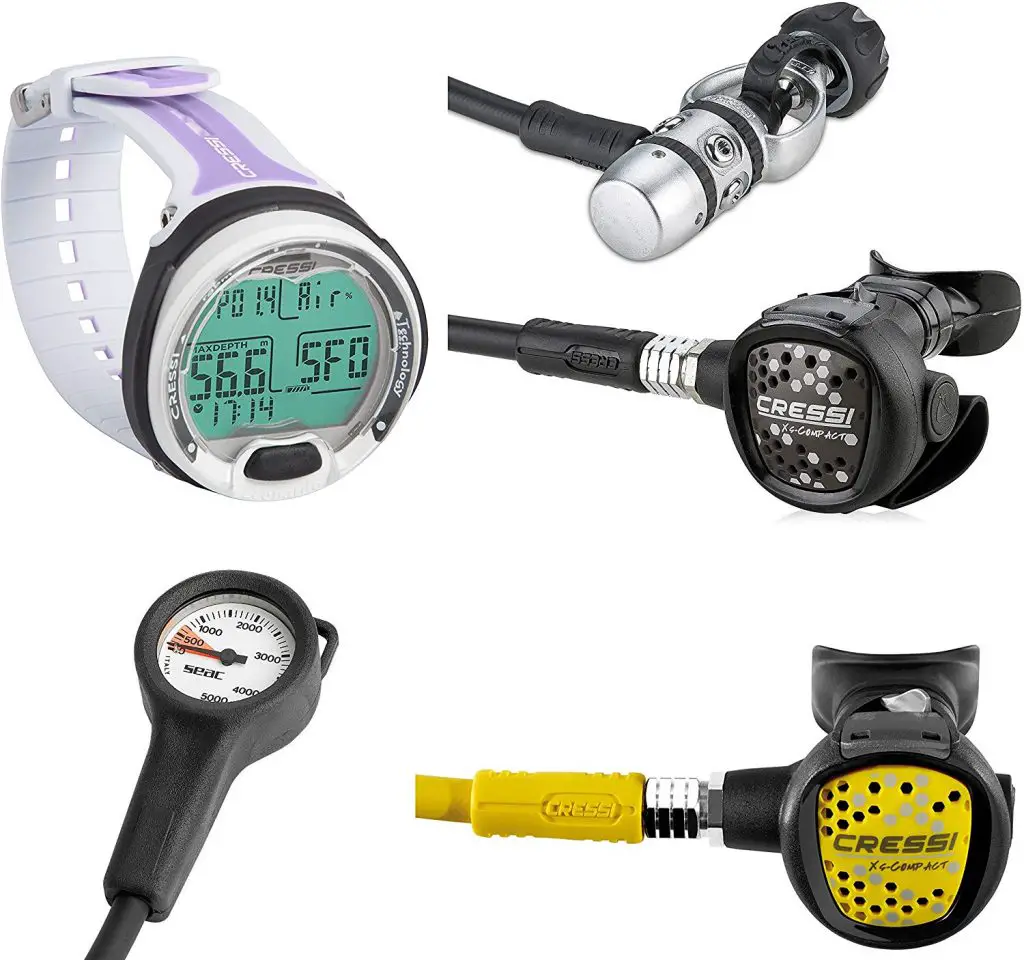Choosing the best scuba regulator under $300 might not always be easy. Most people do not understand the technical aspects of scuba regulators, which is why sometimes it can be confusing to some people what makes the best scuba regulator. Well, worry no more as we will help you learn more about scuba regulators in this guide.
We will look at the various essential parts of a scuba regulator, the best scuba regulators under $300, and buying tips to help you end up with the best unit.
Scuba Regulator Parts You Should Know

If you buy the best budget scuba regulators for under $300, you need to learn more about its parts. Here are some of the essential details you should know.
First Stage
The first stage, the scuba regulator, regulates the airflow from your scuba tank in stages when the air goes from the tank and pressure ports until it reaches the diver.
As the name suggests, this is the primary connector you set up to your scuba tank. Its work reduces the high pressure of the air coming from the tank to a lower intermediate pressure.
The lower intermediate pressure is still not safe for humans to breathe directly. As such, there is the need for a second stage to reduce it further.
Primary Second Stage
This stage is in the diver’s mouthpiece. The airflow at this point will be at a lower pressure. During this second stage, the pressure is reduced to an ambient pressure from the intermediate pressure of the previous stage.
The ambient pressure is equal to the water or pressure surrounding the diver, and this should make it safe for the diver to inhale the air directly with dynamic flow control.
It is worth noting that there are two-second stages, and the primary second stage is attached to the standard open water regulators.
Alternate Second Stage
This stage is treated as an alternate air source or, as some would call it, buddy regulator or octopus. It functions just like the primary second stage mentioned above.
This second stage aims to serve as a backup if there is an emergency with pressure ports or when a diver has to share the air with another diver.
For ease of identification, you will find this stage being brightly colored.
Submersible Pressure Gauge
It is also commonly referred to as SPG. This part aims to help the diver monitor the amount of air remaining in the scuba tank. The last thing a diver wants is to run out of air while underwater. So this SPG will be connected to the first stage by using a high-pressure hose to handle the air’s immense pressure from the tank.
Another option for this would be using a dive computer. This computer aims to provide you with real-time data and a sharper accuracy of the remaining time before the air supply runs out.
Low-Pressure Inflator Hose
A low-pressure inflator hose is another essential part of a regulator and pressure ports. This hose is vital for carrying the intermediate air pressure onto the Buoyancy Compensator inflator from the first stage. To fill this inflator, the diver has to press a button that activates the pressure ports.
Now that you know more about the various parts to expect with the best scuba regulator under $300, it is right to look at the available products. Let us look at some of the top regulators you can buy below.
Top 5 Best Scuba Regulators Under $300
Our Top Pick
[wp-review id=”252″]
Runner’s Up
[su_service title=” Scuba Choice Palantic AS206 Second Stage Regulator ” icon=”icon: star” icon_color=”#2D3092″ size=”32″ class=””][/su_service]

For those looking for a second stage regulator, then this is an excellent option to consider also. It comes with a non-adjustable second stage and a bright yellow octopus. It is always good to have the buddy regulator, as you may never know when it might come in handy.
We like it also for being affordable, and it is the reason we have it as the best scuba regulator under $300. As much as other expensive models, this one will still live up to your expectations as the best affordable scuba regulator with dynamic flow control.
Divers love it for having a comfortable silicone mouthpiece. However, it would be best if you had a great time using this regulator in your mouth, even for long drives, without getting jaw fatigue. Therefore, the manufacturer contoured it to fit perfectly over your mouth to avoid any discomfort with the din regulator.
The purge button is significant to help with ease of operation. But, overall, we find it is generally easy to work this regulator just as you want.
[su_row class=””] [su_column size=”1/2″ center=”no” class=””][su_box title=”PROS” style=”noise” box_color=”#115F23″ title_color=”#FFFFFF” radius=”8″ class=””] ✔️It is easy to use ✔️Comes with the buddy regulator ✔️It is comfortable in your mouth [/su_box][/su_column] [su_column size=”1/2″ center=”no” class=””][su_box title=”CONS” style=”noise” box_color=”#B20010″ title_color=”#FFFFFF” radius=”8″ class=””] . ❌The overall durability could be better . [/su_box][/su_column] [/su_row]
[su_service title=” Cressi AC2/X52 Complete Regulator for Scuba Diving ” icon=”icon: star” icon_color=”#2D3092″ size=”32″ class=””][/su_service]

This model comes from a top brand, so we expect it to live up to our high-quality product expectations. Well, that is what it does. You would not be disappointed in getting one for yourself.
This is a complete regulator with both the first and second stages. So you would not have to worry about getting the two separately. In addition, this unit has been reviewed over the years to ensure that it becomes better and stronger. As a result, we now have a model that is easy to use while remaining durable.
The second stage is made from a hi-tech polymer material to provide you with the best reliability and durability. It also feels comfortable in your mouth, and this is a crucial factor, especially for those who have to dive for long hours.
[su_row class=””] [su_column size=”1/2″ center=”no” class=””][su_box title=”PROS” style=”noise” box_color=”#115F23″ title_color=”#FFFFFF” radius=”8″ class=””] ✔️It is easy to purge ✔️It is a high-performance product ✔️The second stage has a comfortable mouthpiece [/su_box][/su_column] [su_column size=”1/2″ center=”no” class=””][su_box title=”CONS” style=”noise” box_color=”#B20010″ title_color=”#FFFFFF” radius=”8″ class=””] . ❌Unclear setup instructions . [/su_box][/su_column] [/su_row]
[su_service title=” Mares Rover 15X Dive Regulator Scuba Diving ” icon=”icon: star” icon_color=”#2D3092″ size=”32″ class=””][/su_service]

This should appeal to you for those in the market for the lightweight regulator. The unit has both the first and second stages set into it. As a result, you will have an easier time setting it up and not worry about your overall safety while using the regulator.
We also find that the model is abrasion-resistant and still affordable. To be abrasion-resistant means that it would still work great in various conditions and remain looking good. For example, the manufacturer recommends it for diving in moderate and warm temperatures.
The Mesh Grid Patented design is all about reducing the water impact flow onto the second stage diaphragm. The result is you do not have to worry about reduced functionality even when using it in strong currents.
There is also the vortex-assisted design air bypass tube integrated into the model. This part aims to deliver the air to your mouthpiece with the proper pressure so that you can breathe better.
[su_row class=””] [su_column size=”1/2″ center=”no” class=””][su_box title=”PROS” style=”noise” box_color=”#115F23″ title_color=”#FFFFFF” radius=”8″ class=””] ✔️Impressive functional construction ✔️High durable scuba regulator ✔️Designed with diver safety in mind [/su_box][/su_column] [su_column size=”1/2″ center=”no” class=””][su_box title=”CONS” style=”noise” box_color=”#B20010″ title_color=”#FFFFFF” radius=”8″ class=””] . ❌Not the easiest to use on this list . [/su_box][/su_column] [/su_row]
[su_service title=” Oceanic Alpha 8 Scuba Regulators ” icon=”icon: star” icon_color=”#2D3092″ size=”32″ class=””][/su_service]

If you are looking for the best value for money, then consider getting this one also. It is within the affordable range for a scuba regulator but still has the best features of an expensive one. For this model, we found that it has the best price-to-performance ratio in its class.
To help you feel comfortable buying this unit, it is designed and built to perform according to the US Navy Class A standards. It is easy to see why it is a popular model in the market right now with such construction for high pressure.
We also found that it is inexpensive to maintain and does not need much maintenance. So long as you follow the manufacturer’s guide on how to take care of this unit, then you should be fine.
Most found it easy to use as compared to some models. In addition, the manufacturer provides clear setup instructions that you can follow to have the regulator up and running.
[su_row class=””] [su_column size=”1/2″ center=”no” class=””][su_box title=”PROS” style=”noise” box_color=”#115F23″ title_color=”#FFFFFF” radius=”8″ class=””] ✔️Impressive performance for the price ✔️Inexpensive to maintain ✔️Setting it up is easy [/su_box][/su_column] [su_column size=”1/2″ center=”no” class=””][su_box title=”CONS” style=”noise” box_color=”#B20010″ title_color=”#FFFFFF” radius=”8″ class=””] . ❌Lacks the buddy regulator . [/su_box][/su_column] [/su_row]
Buying Guide for the Best Scuba Regulator under $300

The Type of Diving
Before you can buy the best scuba regulators under $300, you should always consider what type of diver you are first.
You could be a tropical recreational driver or a more technical and advanced driver who prefers diving in cold water, deep diving, and many more.
For someone who does tropical warm water diving, then any scuba regulator should work fine for them. However, things are different for someone who does cold water diving. Such a person needs a better cold water diving regulator with more features to handle any high-pressure environmental conditions.
Sealed or Unsealed
Depending on where you dive, sometimes you have to consider if the regulator is sealed or unsealed. A sealed diving unbalanced regulator will prevent water from freezing in the first stage, thus blocking the air from flowing to the next stage. The same seal is vital to avoid sediments, salt, and other contaminants entering the first stage. This type of scuba regular will be ideal for cold diving.
On the other hand, the unsealed balanced regulator is for tropical dives, and it does not matter whether the water inflates the first stage as it would still work. You should find them being cheaper than their sealed counterparts.
Unbalanced or Balanced
You will also come across terms such as balanced or unbalanced. A balanced scuba regulator provides you with consistent airflow regardless of the remaining air supply or the depth at which you are.
The unbalanced regulator will keep on reducing the airflow and high pressure depending on the depth. This might make it difficult for you to breathe whenever the air supply is low or when you go deeper into the water.
A balanced regulator might be more expensive, but it is worth the investment to help you breathe better underwater.
Diaphragm or Piston
Depending on the model, some might have a piston or diaphragm construction. The piston construction will have fewer moving parts and thus making it more reliable. It is a top choice for deep divers or cave divers.
The diaphragm first stages will be cheaper and primarily designated for recreational divers.
Comfort
It is important to feel comfortable while breathing underwater. It comes down to the comfort you get with a scuba regulator, and the mouthpiece primarily determines the comfort. You should never overlook this feature, as it might make your diving experience better or worse.
Look at how hard or easy it is to maintain the bite the whole time you are underwater. Also, if you breathe, is there any noise? These are the questions you need to ask if you hope to end up with a comfortable scuba regulator.
Conclusion
The best scuba regulators under $300 should be safe, comfortable, and durable for you to enjoy diving as a hobby. We have reviewed multiple models above, showing that you can get the best scuba regulators even when on a budget. Check out the buying guide to learn more about the critical features to consider to end up with the proper scuba regulator for your needs.






